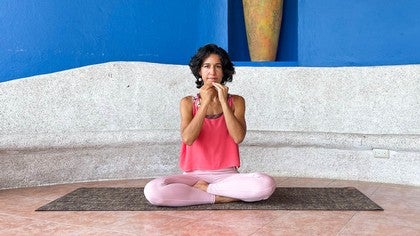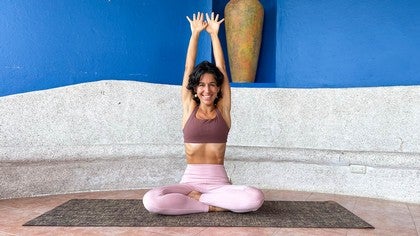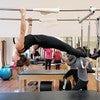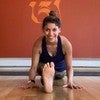Description
About This Video
Transcript
Read Full Transcript
Hi, thank you for being here. In this video, we're going to experience a release of our jaw, our eyes and the back of our skull. So we'll start lying on our mat, just coming into a comfortable position on your back. And if in order to be comfortable lying on your back, you need some support behind your thighs or a thin pillow under your neck, go ahead and do that for yourself. Just make sure that it's really absolutely necessary.
The ideal is to do this completely flat on the ground. So we'll just come onto our back, separate our legs, a comfortable distance away from each other, one that encourages the lower back and the pelvis to feel very easy and comfortable on the mat. And your arms will be a little distance away from your body with your palms turned open. And again, just noticing that the distance between arms and body between the legs is comfortable for your trunk, for your neck, your shoulders, your low back and your pelvis. And just take a moment to close your eyes and just notice how you feel in this now moment, and just sensing the space around you.
How do you perceive the space? Does it feel vast and open, or can you sense where the walls and the ceilings and windows might be? And noticing the ground underneath you and the contact that your body makes with it. And as you become aware of the points of contact between yourself and the floor, allow yourself to release into them. And we'll encourage every following inhalation to move into the body a little bit slower so that it takes more time and really fills you up.
And as you exhale and release, notice the weight of your head releasing around your shoulders and chest, softening the area of your abdomen and waist. And noticing the weight of your pelvis and the letting go through your groin, front of your thighs, calves and feet. Inhaling slowly and fully, and just feeling where your body expands and sensing how you feel that. Is it thanks the floor, the contact you have with your clothing? Is it through your skin?
And as we exhale, falling back and letting go. And on our following inhale, we'll start to point through our toes, feeling the heels slide up towards our head a little bit. And as we exhale, we'll gently flex through our ankles, sliding the heels away from the head, inhaling to point through the toes, exhaling to flex through the ankles. (exhales) Relax your face, relax your jaw. And notice if as you're pointing your ankles, you can sense the movement through the back of your pelvis, possibly through the back of your head and through your shoulders.
When we inhale to point our ankles, our tailbone will roll into the mat. And as we exhale to flex at our ankles, our tailbone will relatively roll towards the sky. And it might be subtle, but obvious enough to feel the subtlety, right? To feel the relationship between the ankles and what's happening at your pelvis. And now traveling up towards the back of your head and sensing if you're rocking at the back of the head as well or not.
And when you feel ready, you'll just relax that, let everything go, allowing the body to just gently fall back and release. And on the following inhale, very gently start rolling the chin towards the shoulder. You can roll in your favorite direction, go slowly enough so that you can really feel the weights of the back of your skull and the movement and massage that you can offer yourself here. Inhaling or exhaling to allow your head to roll gently to the other side, and then slowly breathing to roll your head back up through your center. And we'll just do this one or two more times to each side.
Continuously asking your breath to slow down just a little bit more. Feeling how the body inflates as the breath rises and how the whole body lets go as the breath empties. And with it, your head rolls. The next time that your head is centered on the mat, go ahead and pause there. Wait for your following inhalation, keeping your head centered on the mat, allow yourself to fill and expand.
Notice the upward rise the inhale creates. Exhale all the air out, falling back into the mat. And now on our following inhale, we'll keep our eyes closed at first and open the mouth as wide as we can, moving very slowly and gently. As we exhale, closing the mouth and allowing the jaw to release. You'll stay on your back, releasing your body weight into the mat.
As you're inhaling, opening your jaw, as you're exhaling, closing your jaw, (exhales) and repeat this for a few more moments. Notice that as you inhale to open your jaw, the back of your head will slide on the mat. And as you exhale to close your jaw, the back of your head will again, slide back on the mat. So we'll just keep repeating this for a few more moments with our eyes gently closed, tuning into the slide and the relationship of the back of the head with the floor as you move in your jaw. And the next time that you exhale and close your mouth, go ahead and pause there.
And on your following inhale, you'll open your eyes. Now, if you're feeling any discomfort in your lower back at this point, you're welcome to bend your knees, stand your feet into the ground. Always take care of yourself when your body is asking you for some change. Right now we wanna make ourselves as comfortable as possible. Now keeping your eyes open, on your following inhale again, open your jaw gently yet thoroughly.
Notice how far you can go through the base of your jaw with your eyes open. And as you exhale, allow your jaw to close and release. Notice what your eyes want to do as you're opening your jaw with eyes open. We'll do this just one more time. And as you exhale, closing the jaw and just relaxing your gaze.
And for a moment, go back to closing your eyes. And we're just gonna notice the sensation around our face, keeping the weight of the back of the head heavy on the mat. And again on your following inhale, encourage your breath to come in just a little bit slower, a little bit fuller. Notice how a slow inhale will rise up towards your head. And as you exhale, release around your eye sockets, feel the weight of your eyeball dropping back into its socket, release around your cheekbones and your jaw.
And just notice how your tongue sits in your mouth. Feel a release around the base of the jaw, around the root of your tongue. As you exhale, feeling how your eyeballs can slide back into their cavity, how the back of the head and the jaw can all slide back and release. Now on your following breath, very gently keeping this space between the teeth relaxed, the tongue resting. On your following inhale you'll use your tongue on the inside of the mouth to press the jaw open, and then close the mouth and release.
So again, it might feel strange, but it's the idea of pressing of using the tongue to gently push down into the bottom part into your jaw and open your mouth that way. Now on this next one, we'll do this with our eyes open and just notice how the eyes respond to the movement of your jaw. The next time that you close your mouth, pause for a second, taking in one full inhale, just letting the movements release as you exhale, releasing all effort in the jaw and around your tongue. And on your following inhale this time, we'll do the same thing except now you're going to reach the tongue out of the mouth as it helps to push the jaw down. And again, tune into the relationship of the back of your head with the floor.
Closing the jaw, release everything, allow the back of the head to slide and release. And you can always take breaths in between the opening and closing of the mouth 'cause what's most important is to keep coming back to the state of feeling fully supported, where you're really allowing yourself to receive the embrace of letting go. And the next time that you close your mouth, you'll release that for a moment. And now this time you'll bring your hands onto your chin, just so you can feel where your jaw is, feel where your chin is. And now this time, listen to this first, the goal is to keep the chin where it is and to open the skull on the jaw.
So rather than pushing the chin down, this time our intention is to keep the chin heavy, keep the jaw really heavy, where the chin sits on this heavy jaw and on our following inhale, we can open our eyes and slide the skull back. And then closing the jaw and returning to your start position again. So we'll just play with that for a few moments. The jaw stays in place, the skull moves open and back on the jaw. And again, notice the feedback you're receiving from the ground.
If, and whenever it becomes a bit blurry, a bit strange, pause, take a breath and then differentiate the experience of moving the jaw on the skull, where you can even use your tongue to push it down. Then bring the jaw back to where it's in that release start position. Keep the jaw where it is, your fingers on your chin are very helpful to help have the awareness about where it is and then again, rolling the skull back on the jaw. We'll just spend a few more moments here. Notice the relationship between moving the jaw, moving the skull on the jaw and the neck?
And now when you feel ready, allow your arms to come back down at your sides if they're not, they're already. Stretched your legs all the way back out if you had bent your knees and for just a moment longer return to just lying flat on your back, and notice the way that you feel. Inhaling slowly and fully, sensing the upward movement of a deep inhale. And as you exhale as if this balloon of inhale is losing air, allow your head to start rolling gently in one direction, the head just kind of falling off of the midline. As you inhale slowly and fully feel the rise of the inhale, roll your head back through your center.
Exhale slowly, feel yourself sink back and just gently drift and roll over to the other side with your head. Wait for the inhale, feel the rising of the breath and allow it to guide your head back and through your center. Exhaling slowly, allowing the release to roll the neck one more time. The next time that your head comes back up and through the center, go ahead and just pause there, on your following inhale, you'll reach your arms up and over your head. Take them as close to the floor over head as it feels comfortable, exhale and stretch all the way out, stretching to yawn, literally trying to provoke a yawn.
And then as you're ready, allow your arms to come back down and gently turn to lying on your side. You can lie on whichever side is most comfortable. Hug your knees into your chest. Use your bottom arm as a pillow, make yourself very comfortable and just stay there for two or three breaths. And when you feel like you're ready, you'll slowly make your way up into a comfortable seated position.
And as you come up, just settling on your seat here, and as we inhale, we'll draw our shoulders up towards our ears smoothly, gently press the back of the neck into the shoulders. And as we exhale, release the shoulders down, relax your face, your jaw and your tongue. One more time, inhale, glide the shoulders up, gently press the neck back. Notice that now the head has somewhere to squeeze into, exhale gently release shoulders down. Look straight ahead and relax your face.
Last one. I hope your face and neck feel a little more refreshed and that you can see and speak with greater clarity. Thank you.
Mindful Movement: Movement is Medicine
Comments
You need to be a subscriber to post a comment.
Please Log In or Create an Account to start your free trial.


























